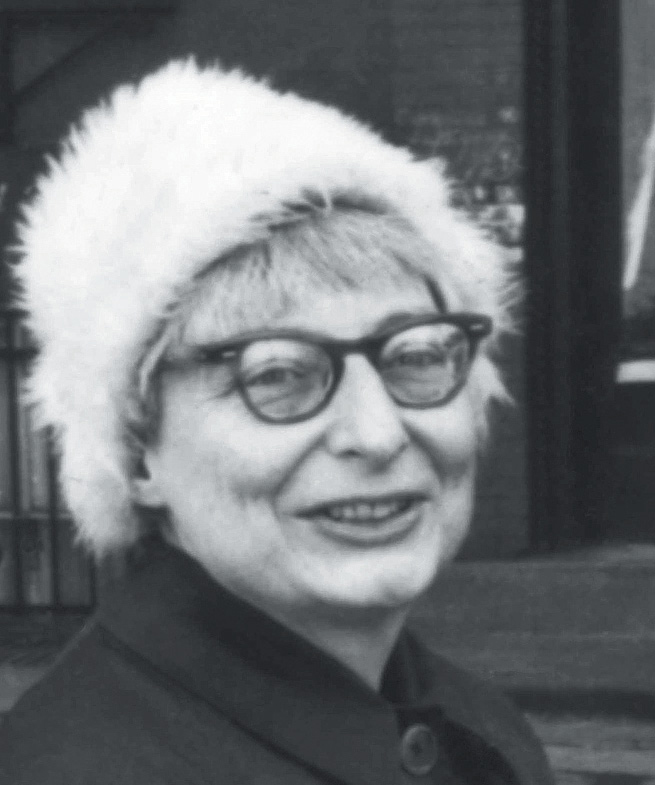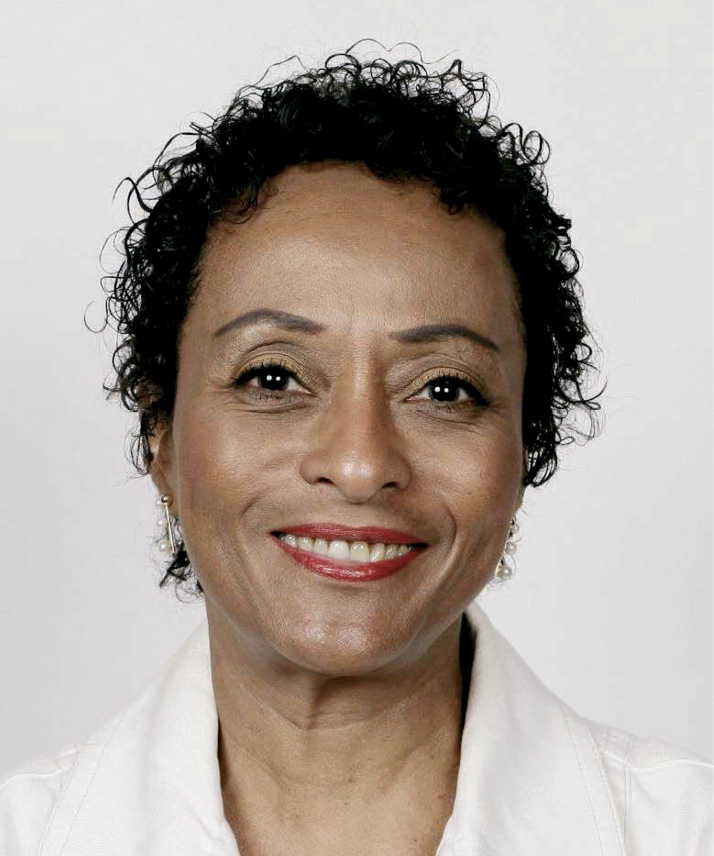Jane Jacobs and Peggy Shepard

JANE JACOBS

PEGGY SHEPARD
Chelsea
As a girl from Scranton, Pennsylvania, Jane Jacobs’s first glimpse of New York City came on a school trip in 1928. As her class emerged from the Holland Tunnel into Lower Manhattan, she recalled being “flabbergasted by the number of people in the streets… the city was just jumping.” That amazement and curiosity would shape her work on urban planning, which would define much of her life.
After high school and a stint working an unpaid job at the local paper in Scranton, Jane left for New York, this time for more than a field trip. In her new hometown, she rode the subway, getting off at different stops to apply for jobs and explore neighborhoods. In Greenwich Village, she found both a secretarial job and a community.
During World War II, Jane worked for the Office of War Information. Following the war she started writing for Amerika, a pro-America Russian-language magazine. She was hounded by McCarthyism and investigated by the FBI because of her beliefs. In response, she wrote: “I do not agree with the extremists of either the left or the right, but I think they should be allowed to speak and to publish, both because they themselves have, and ought to have, rights, and once their rights are gone, the rights of the rest of us are hardly safe.”
After leaving Amerika, Jane went to work for another, albeit quite different, magazine, Architectural Forum. She would later recount how, upon learning she was intended to be the publication’s new expert on schools and hospitals, she became immediately suspicious of experts given how little she knew about both. Still, she was determined to learn all she could—first about architecture, then about urban planning and design. She began to question what made a city healthy—or not—and spent years researching what would become her seminal 1961 book, The Death and Life of Great American Cities. Putting “death” before “life” in the title was clearly purposeful. Many saw it as an attack on the status quo in city planning—probably because, in the book’s introduction, she declared it “an attack on current city planning and rebuilding.”
In her book, Jane criticized urban planning as “pseudoscience,” with no real basis in facts, and she outlined the real destruction such planners were wreaking on communities where they themselves rarely lived. She popularized and may even have coined the terms “social capital,” to articulate what provides cohesion for communities and other social groups, and “mixed primary uses,” to explain why neighborhoods where people lived and worked were healthier than those where people do only one or the other. She gave us the beautiful phrase “eyes on the street,” to talk about how in mixed primary use neighborhoods there were always people around—off early to work, walking kids to school, going about their day, going out at night, closing the bar, heading home after the late shift. And she wrote about how those neighborhoods, like her own in Greenwich Village, that engaged in a “sidewalk ballet” of consistent movement were more vibrant and protective. Those are the kinds of neighborhoods for living and working she wanted for everyone in urban environments.
Students in urban planning, architecture, economics, public health, history, and more study Jane’s work today; I certainly did while pursuing my master’s in public health at Columbia University’s Mailman School of Public Health. Her reputation now is a contrast to the reaction she received from the male professional class in the 1950s and ’60s. When her first articles came out criticizing contemporary urban renewal practices, she was called a “crazy dame.” After she published her first book, the criticism was even fiercer and more sexist. Her lack of credentials was derided (she never graduated from college), and she was dismissed as “just a mother.” She must have had moments of discouragement. But chauvinism couldn’t stop the power of Jane’s ideas, her voice, or her example.
Jane was not only a hugely important thinker and writer; she was also a powerful activist. In the 1950s and ’60s, she spoke out against the efforts to develop East Harlem without including the East Harlem community; organized to stop slum clearance in her beloved Greenwich Village and a plan to run Fifth Avenue through Washington Square Park; helped stop the proposed Lower Manhattan Expressway, which would have cut through neighborhoods; and trained countless citizens, particularly women, to be powerful advocates for the city they wanted. In 1968, while protesting the latest Lower Manhattan Expressway plans, she was arrested, spent a night in jail, and was later convicted of disorderly conduct.
Jane commuted to her court appointments from Toronto, where she had moved in 1968 partly in protest of the Vietnam War. There she again helped stop proposed expressways that would have cut up and disjointed neighborhoods, and again fought for urban planning that included, rather than excluded, community voices. She passed away in 2006, at eighty-nine, her life defined by her ceaseless work for the cities she thought everyone, whether in New York, Toronto, or anywhere else, deserved.
Like Jane, Peggy Shepard refused to be deterred by powerful corporations or leaders who would have preferred she sit down and shut up. After she was elected the Democratic Assembly district leader for West Harlem, she faced a serious question from her constituents—what could she do about a new sewage-treatment facility that had opened on the Hudson River and was emitting noxious fumes that families were convinced were making them sick? It also smelled like rotten eggs. Peggy drew on her skills as a former journalist and speechwriter for the New York State Division of Housing and Community Renewal and started investigating what was happening in her neighborhood. She learned that the new North River Sewage Treatment Plant had first been planned for a different part of Manhattan, well south of Harlem, and questioned why it had been moved. Was it because her neighborhood had among the lowest incomes in New York City? Because it was majority black? Because the city didn’t think her neighborhood would notice that people were getting sick? All of the above?
Peggy kept asking these tough, important questions about racism, class, equity, and public health. She discovered that the City Planning Commission had never asked her community what it thought about a proposed waste treatment facility. Under pressure from Peggy and other local political and civic leaders, including filing a lawsuit, the city upgraded the facility to remove harmful fumes from the air and much, though not all, of the bad smell. And New York State’s long-delayed promise to build a park on top of the plant finally began to take shape. After being approved in 1970, it finally opened in 1993.
The fight for city accountability and action on the North River Sewage Treatment Plant led Peggy to cofound WE ACT for Environmental Justice, to fight environmental racism in West Harlem and for meaningful participation by communities in the policies and plans that impact their neighborhoods and lives. Its record shows it has done just that, repeatedly, from the local to the national levels.
WE ACT’s efforts led to the creation of West Harlem Piers Park, after the city had neglected to include Harlem in its new parks planning effort. The group pushed for new bus emission standards that required New York City buses to move from diesel to hybrid, leading to a 95 percent drop in tailpipe emissions. They worked to pass legislation to get lead out of New York City public housing and schools, and now are working to have those standards enforced. At the national level, they’re working on setting robust environmental standards and ensuring that urban low-income communities are not forgotten, and are included in national legislation, like the annual farm bill.
Peggy has worked with the National Institutes of Health, served as the chair of the Environmental Protection Agency’s National Environmental Justice Advisory Council, and cochaired its Research and Science Workgroup, a powerful statement about how vital it is to have community leaders be part of designing research standards and selecting research programs. WE ACT works with researchers at the local level in New York and also trains and supports local activists and advocates, continually building a multidisciplinary movement to fight environmental racism. It makes perfect sense that Peggy Shepard received the 2008 Jane Jacobs Lifetime Achievement Award, among countless other accolades. Both women understood that fighting for the change they knew was necessary was more likely to draw criticism than acclaim, but they never let that stop them from doing what needed to be done. They continue to inspire the next generation of environmental activists, including Majora Carter and Adrianna Quintero, who work for environmental justice to protect the health of black and Latino communities, including in New York City. The work they and other women are doing to build greener, more sustainable futures and fight the rollback of regulations that have safeguarded and improved our air, water, and land is critical. I like to imagine Jane agitating, advocating, and working alongside Peggy and others, and cheering them on.